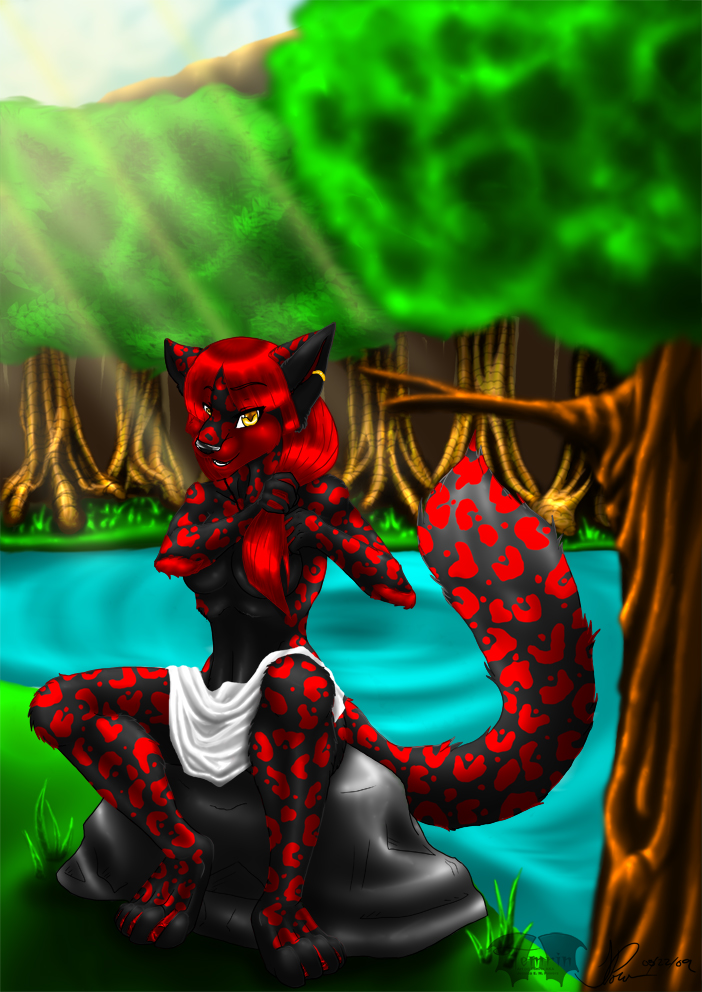
| Plural | Pendragons |
| Height | 1.65 m - 2.18 m |
| Weight | 45.35 kg - 158.76 kg |
Extremely versatile and telepathically connected to Fronima, the Pendragon [ˈpʰɛnˌdɹæ gjn̩] is the most prolific race on the planet Ramath-lehi. Pendragons have furry bodies and long whip-like tails. All Pendragons fall into one (or two) of the following appearance types:
- Felid. Short or sometimes non-existent snouts, sharp triangular ears, and small noses.
- Canid. Long snouts, large ears, and fleshy noses.
- Draconic. Long snouts, sometimes no protruding ears, and serpentine nostril slits.
Pendragons are digitigrades, but their paws have evolved for dexterity. They have longer fingers on their forepaws as well as a prehensile thumb which makes it easier for them to work and handle things. They have five toes on each forepaw and back paw. Embedded within the paws are thick, retractable cat-like claws.
Due to their unique body structure, Pendragons are capable of both bipedal and quadrupedal locomotion and can freely switch between either mode. However, if one mode is favoured over the other through most of a Pendragon's life then it will likely affect the shape of the body. For example, a Pendragon who has spent the majority of their childhood in bipedal mode are fairly erect in posture during adulthood.
Pendragon colours range dramatically, as they have taken on all of the hues of the visible light spectrum (and some of the non-visible).
¶ Sexual Dimorphism
Most male Pendragons have flickering Fronima flames on the tips of their tails. The tail-flame mutation can also occur in females, but it is not as common. 85% of male Pendragons have tail-flames compared to 27% of females. Males born without tail-flames are often called nullfires, which holds negative connotations and implies that the individual lacks magical heritage or power. The colour, size, and appearance of a tail-flames is reflective of a Pendragon's mood and health. All Pendragons are capable of telepathic thought-speak.
¶ Reproduction
Pendragons lay eggs and are monotremes. They lay eggs, yet still hang around to suckle their young. The eggs must be incubated and kept warm for roughly 40-50 days, about a quarter of a Ramathian year, during which they must be protected by a parent. Once hatched, the hatchling must be protected until they are able to take care of themselves.
¶ Quarterly Heat Cycles
Every fifty days, or every season, a sexually mature female Pendragon enters a two-phased heat cycle. The first step lasts roughly five days, and no noticeable physical changes occur. The female is merely receptive, and the only way this is apparent is by her "chemical signature", present by scent, particularly in her urine. Due to evolution and the development of innovated civilization, this chemical output has been muted greatly, so it is less communal when a female is in season. During this short span of time, the female's drive to mate will be greater than normal.
If the female chooses not to mate, she will not conceive, and thus she will enter the next phase of her cycle. Because she does not need the wall of tissue in her womb to nourish a developing egg, the female will shed the uterine lining. This process lasts another five days. When both phases are over, the female Pendragon's body will slowly begin to acquire a new lining, and the process will continue next season.
¶ Intercourse and Pregnancy
Pendragons are sexually active throughout the year, with no particular mating or breeding season. When a couple wants to conceive, they have to time intercourse so that it takes place during the female's receptive heat phase.
After conception occurs, an egg grows within the female Pendragon. It remains there and grows for roughly 20 days. Once the egg is laid, it takes 40 to 50 days of incubation for it to hatch.
In the "internal phase," i.e., during the twenty days when the egg is still within the female, she does not show much. Her abdominal area may grow a little, but there's no major swelling. Perhaps just enough of a bump to tell she's with egg.
¶ Health
In a perfect world, Pendragons would have no set life span; they grow more powerful as they age. They could live near forever if it wasn't for elements, murder, illness, and accidental deaths. However, the average life expectancy of any given pendragon is roughly 80 to 140 years.
Pendragons start with bonuses to Pilot and Physique.
¶ Diet
Pendragons have large fangs for ripping and tearing. They are born carnivores, but some have slipped over and became omnivores - and some have even taken it as far as to become vegetarians. They have 36 teeth consisting of both large canines and molars. Their molars are defined for grinding and chewing foods thoroughly.
¶ Culture
The majority of Pendragons are marked with tattoos. A Pendragon’s first tattoo is usually on their left haunch. These are symbols that their parents thought would reflect the young Pendragon's personality. Parents will often consult a local seer to gain insight as to what a Pendragon's first tattoo should be.
¶ Social Structure
Pendragons live in family clans, tribes, or by their lonesome. Family clans usually consist of a mother, father, and their young. Some Pendragons exist in larger tribes with three families or more, and some prefer to be alone in remote regions of the world.
¶ Parenthood
Males and females are equal caretakers. Males will help to incubate the egg, as well as nurse the hatchling and care for it.
¶ Language
¶ Religion
- Pendragons follow a wide variety of religions.
¶ Traditions
- Addfesmatt Fastening Tradition An upper class Swarajian wedding tradition.
- Omesea A marriage tradition dedicated specifically to same sex couples.
- Omesjei Tradition A simple marriage tradition with emphasis on friends and family and tail-flame born jewelry.
- Rympemd Tradition A rather modern marriage tradition from Sudesha.
¶ Habitat
Pendragons may be found just about everywhere on Ramath-lehi.